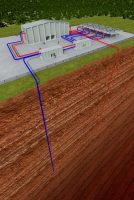National labs, universities collaborate on enhanced geothermal systems experiments

The U.S. Department of Energy (DOE) recently launched a new project to develop experiments to better understand rock fractures in
order to remove technical barriers to commercializing enhanced geothermal systems (EGS).
Conventional geothermal technology requires heat, fluid and permeability – a measure of how easily a fluid can flow through a rock’s fractures. EGS enables fractures to be created or enhanced.
EGS may be able to provide more than 100 gigawatts (GW) of economically feasible, electric generating capacity in the continental
United States. Geothermal capacity in this area is currently 3.5 GW.
Lawrence Berkeley National Laboratory (LBNL) leads the project, called EGS Collab, which also involves seven other DOE national
labs and six universities. It aims to improve the understanding of the relationship between permeability creation and heat extraction in crystalline rocks under certain stress and temperature conditions.
“We will be putting instrumentation within tens of meters of the fractures and will be able to detect fracturing at a higher resolution than whatever has been done before,” LBNL’s Tim Kneafsey, who serves as project lead, said. “The goal is to work toward commercialization of enhanced geothermal systems, which could eventually provide a very significant amount of electricity as there is a lot of accessible hot rock in this country.”
DOE geothermal project the Frontier Observatory for Research in Geothermal Energy (FORGE) will use knowledge gained from this project to develop the technologies for creating large-scale, cost-effective heat exchange systems in order to reduce risks related to EGS commercialization.
